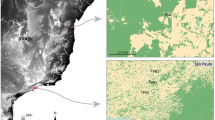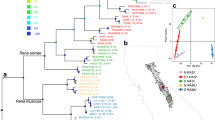Abstract
Amphibian populations are being threatened by human related activities including the spread of the fungal pathogen, Batrachochytrium dendrobatidis (Bd) and urbanization. With growing losses in global amphibian biodiversity, it is essential to document how amphibian populations are responding to rapid environmental changes. While most evolutionary processes, e.g. changes in allelic frequencies, may be too slow to allow adequate response to environmental changes, epigenetic modifications can rapidly translate environmental changes into adaptive phenotypic responses. Epigenetic modifications come in multiple, non-exclusive forms, the most notable being DNA methylation. Here we sought to examine variation in the frequency of DNA methylation among four túngara frog populations distributed across Gamboa, Panama; which vary in both their level of fungal presence/prevalence and urbanization. DNA samples were collected from amplexed (male–female) pairs and frequency of DNA methylation was analyzed using a methylation-sensitive amplified fragment length polymorphism protocol. We found significant variation in DNA methylation among populations, and correlations between Bd infection status and methylation patterns. Urbanization, however, had no influences on the frequency of DNA methylation. These data suggest epigenetic modifications are substantially flexible across fine-scale, environmental gradients and there appears to be possible biologically relevant links between DNA methylation and Bd infection status. Our results provide a basis for future work investigating the causal role epigenetics have in mediating phenotypic response to human-induced, environmental changes.


Similar content being viewed by others
Availability of data and materials
The datasets generated during and/or analyzed during the current study are available from the corresponding author on reasonable request.
References
Asplen MK, Anfora G, Biondi A et al (2015) Invasion biology of spotted wing Drosophila (Drosophila suzukii): a global perspective and future priorities. J Pest Sci 88:469–494
Becker G, Zamudio KR (2011) Tropical amphibian populations experience higher disease risk in natural habitats. PNAS 108(24):9893–9898
Bender J (2004) DNA methylation and epigenetics. Annu Rev Plant Biol 55(1):41–68
Berger L, Speare R, Daszak P et al (1998) Chytridiomycosis causes amphibian mortality associated with population declines in the rain forests of Australia and Central America. PNAS 95(15):9031–9036
Bird A (2007) Perceptions of epigenetics. Nature 447:396–398
Bossdorf O, Richards CL, Pigliucci M (2008) Epigenetics for ecologists. Ecol Lett 11(2):106–115
Burggren WW, Crews D (2014) Epigenetics in comparative biology: why we should pay attention. J Integr Comp Biol 54(1):7–20
Ellison A, Lopez CMR, Moran P et al (2015) Epigenetic regulation of sex ratios may explain natural variation in self-fertilization rates. Proc R Soc B 282(1819):20151900
Evanno G, Regnaut S, Goudet J (2005) Detecting the number of clusters of individuals using the software STRUCTURE: a simulation study. Mol Ecol 14(8):2611–2620
Foust CM, Preite V, Schrey AW et al (2016) Genetic and epigenetic differences associated with environmental gradients in replicate populations of two salt marsh perennials. Mol Ecol 25(8):1639–1652
Gao L, Geng Y, Li B et al (2010) Genome-wide DNA methylation alterations of Alternanthera philoxeroides in natural and manipulated habitats: implications for epigenetic regulation of rapid responses to environmental fluctuation and phenotypic variation. Plant Cell Environ 33(11):1820–1827
Greally JM (2018) A user's guide to the ambiguous word 'epigenetics'. Nat Rev Mol Cell Biol 19(4):207–208
Gridi-Papp M, Rand AS, Ryan MJ (2006) Animal communication: complex call production in the túngara frog. Nature 441:38
Halfwerk W, Jones PL, Taylor RC et al (2014) Risky ripples allow bats and frogs to eavesdrop on a multisensory sexual display. Science 343(6169):413–416
Halfwerk W, Blaas M, Kramer L et al (2019) Adaptive changes in sexual signaling in response to urbanization. Nat Ecol Evol 3(3):374–383
Hammond SA, Nelson CJ, Helbing CC (2016) Environmental influences on the epigenomes of herpetofauna and fish. Biochem Cell Biol 94:95–100
Herrera CM, Bazaga P (2010) Epigenetic differentiation and relationship to adaptive genetic divergence in discrete populations of the violet Viola cazorlensis. New Phytol 187(3):867–876
Herrera CM, Bazaga P (2011) Untangling individual variation in natural populations: ecological, genetic and epigenetic correlates of long-term inequality in herbivory. Mol Ecol 20(8):1675–1688
Herrera CM, Bazaga P (2016) Genetic and epigenetic divergence between disturbed and undisturbed subpopulations of a Mediterranean shrub: a 20-year field experiment. Ecol Evol 187(3):3832–3847
Hof C, Araujo MB, Jetz W, Rahbeck C (2014) Additive threats from pathogens, climate and land-use change for global amphibian diversity. Nat Lett 480:516–519
Holland BR, Clarke AC, Meudt HM (2008) Optimizing automated AFLP scoring parameters to improve phylogenetic resolution. Syst Biol 57(3):347–366
Hu J, Barrett RD (2017) Epigenetics in natural animal populations. J Evol Biol 30:1612–1632
Jackson ST, Sax DF (2010) Balancing biodiversity in a changing environment: extinction debt, immigration credit and species turnover. Trends Ecol Evol 25(3):153–160
Jaenisch R, Bird A (2003) Epigenetic regulation of gene expression: how the genome integrates intrinsic and environmental signals. Nat Genet 33:245–254
James TY, Toledo LF, Rödder D et al (2015) Disentangling host, pathogen, and environmental determinants of a recently emerged wildlife disease: lessons from the first 15 years of amphibian chytridiomycosis research. Ecol Evol 5(18):4079–4097
Jirtle RL, Skinner MK (2007) Environmental epigenomics and disease susceptibility. Nat Rev Genet 8:253–262
Johannes F, Porcher E, Teixeira FK et al (2009) Assessing the impact of transgenerational epigenetic variation on complex traits. PLoS Genet 5(6):e1000530
Johnson PTJ, Mckenzie VJ, Peterson AC et al (2011) Regional decline of an iconic amphibian associated with elevation, land-use change, and invasive species. Conserv Biol 25(3):556–566
Jombart T, Ahmed I (2011) adegenet 1.3-1: New tools for the analysis of genome-wide SNP data. Bioinformatics 27:3070–3071
Jombart T, Devillard S, Balloux F (2010) Discriminant analysis of principal components: a new method for the analysis of genetically structured populations. BMC Genet 11:94
Kolby J, Daszak P (2016). The emerging amphibian fungal disease, chytridiomycosis: a key example of the global phenomenon of wildlife emerging infectious diseases. In: Scheld W, Hughes J, Whitley R (eds) Emerging infections, vol 10. ASM Press, Washington, DC
Koo TK, Li MY (2016) A guideline of selecting and reporting intraclass correlation coefficients for reliability research. J Chiropr Med 15:155–163
Kosch TA, Bataille A, Didinger C et al (2016) MHC selection dynamics in pathogen-infected túngara frog (Physalaemus pustulosus) populations. Biol Lett 12:20160345
Lampert KP, Rand AS, Mueller UG, Ryan MJ (2003) Fine-scale genetic pattern and evidence for sex-biased dispersal in the túngara frog Physalaemus pustulosus. Mol Ecol 12(12):3325–3334
Lankau R, Jørgensen PS, Harris DJ, Sih A (2011) Incorporating evolutionary principles into environmental management and policy. Evol Appl 4(2):315–325
Lappalainen T, Greally JM (2017) Associating cellular epigenetic models with human phenotypes. Nat Rev Genet 18(7):441–451
Ledon-Rettig CC, Richards CL, Martin LB (2013) Epigenetics for behavioral ecologists. Behav Ecol 24:311–324
Liebl AL, Schrey AW, Richards CL, Martin LB (2013) Patterns of DNA methylation throughout a range expansion of an introduced songbird. Integr Comp Biol 53(2):351–358
Liu S, Sun K, Jiang T et al (2012) Natural epigenetic variation in the female great roundleaf bat (Hipposideros armiger) populations. Mol Gene Genomics 287(8):643–650
McNew SM, Beck D, Sadler-Riggleman I et al (2017) Epigenetic variation between urban and rural populations of Darwin’s finches. BMC Evol Biol 17:183
Nilsson EE, Skinner MK (2015) Environmentally induced epigenetic transgenerational inheritance of disease susceptibility. Transl Res 165(1):12–17
Nori J, Lemes P, Urbina-Cardona N et al (2015) Amphibian conservation, land-use changes and protected areas: a global overview. Biol Conserv 191:367–374
Palumbi S (2001) Humans as the world’s greatest evolutionary force. Science 293(5536):1786–1790
Paradis E (2010) Pegas: an R package for population genetics with an integrated-modular approach. Bioinformatics 26(3):419–420
Pereira HM, Leadley PW, Proença V et al (2010) Scenarios for global biodiversity in the twenty-first century. Science 330(6010):1496–1501
Perez-Figueroa A (2013) MSAP: a tool for the statistical analysis of methylation-sensitive amplified polymorphism data. Mol Ecol Resour 13(3):522–527
Phillips BL, Puschendorf R (2013) Do pathogens become more virulent as they spread? Evidence from the amphibian declines in Central America. Proc R Soc B Biol Sci 280(1766):20131290
Platt A, Gugger PF, Pellegrini M, Sork VL (2015) Genome-wide signature of local adaptation linked to variable CpG methylation in oak populations. Mol Ecol 24(15):3823–3830
Pounds JA, Crump ML (1994) Declines and climate amphibian the case disturbance: toad and the of the golden frog harlequin. Conserv Biol 8(1):72–85
Pounds JA, Fogden MPL, Savage JM, Gorman GC (1997) Tests of null models for amphibian declines on a tropical mountain. Conserv Biol 11(6):1307–1322
R Core Team (2014) R: A language and environment for statistical computing. R Foundation for Statistical Computing, Vienna, Austria. http://www.R-project.org/
Robertson BA, Rehage JS, Sih A (2013) Ecological novelty and the emergence of evolutionary traps. Trends Ecol Evol 28(9):552–560
Robinson B, Pfennig D (2013) Inducible competitors and adaptive diversification. Curr Zool 59(4):537–552
Rodríguez-Brenes S, Rodriguez D, Ibá R, Ryan MJ (2016) Spread of amphibian chytrid fungus across lowland populations of túngara frogs in Panamá. PLoS ONE 11(5):e0155745
Ryan MJ (1985) The túngara frog, a study in sexual selection and communication. University of Chicago Press, Chicago
Savage AE, Terrell KA, Gratwicke B et al (2016) Reduced immune function predicts disease susceptibility in frogs infected with a deadly fungal pathogen. Conserv Physiol 4(1):cow011
Schrey AW, Alvarez M, Foust CM et al (2013) Ecological epigenetics: beyond MS-AFLP. Integr Comp Biol 53(2):340–350
Sih A (2013) Understanding variation in behavioural responses to human-induced rapid environmental change: a conceptual overview. Anim Behav 85(5):1077–1088
Sih A, Stamps J, Yang LH, McElreath R, Ramenofsky M (2010) Behavior as a key component of integrative biology in a human-altered world. Integr Comp Biol 50(6):934–944
Skinner MK (2014) Environmental stress and epigenetic transgenerational inheritance. BMC Med 12(153):1–5
Smith TA, Martin MD, Nguyen M, Mendelson TC (2016) Epigenetic divergence as a potential first step in darter speciation. Mol Ecol 25(8):1883–1894
Strimmer K (2008) fdrtool: a versatile R package for estimating local and tail area-based false discovery rates. Bioinformatics 24(12):1461–1462
Taylor RC, Ryan MJ (2013) Interactions of multisensory components perceptually rescue túngara frog mating signals. Science 341(6143):273–274
Vaiserman A (2015) Epidemiologic evidence for association between adverse environmental exposures in early life and epigenetic variation: a potential link to disease susceptibility? Clin Epigenet 7(1):96
Weaver ICG, Cervoni N, Champagne FA et al (2004) Epigenetic programming by maternal behavior. Nat Neurosci 7(8):847–854
Wenzel MA, Piertney SB (2014) Fine-scale population epigenetic structure in relation to gastrointestinal parasite load in red grouse (Lagopus lagopus scotica). Mol Ecol 23(17):4256–4273
Whitfield PE, Gardner T, Vives SP et al (2002) Biological invasion of the Indo-Pacific lionfish Pterois volitans along the Atlantic coast of North America. Mar Ecol Prog Ser 235:289–297
Acknowledgements
We thank Salisbury University for providing funding for equipment. We are grateful to Matthew Murphy, Paul Swim, and Tyler Bowling for their assistance with the MS-AFLP procedure. Rosalind Ludovici and Derek Coss assisted with data analysis. We would also like to thank two anonymous reviewers for their input during the drafting of this work.
Author information
Authors and Affiliations
Corresponding author
Ethics declarations
Conflict of interest
The authors declare they have no conflict of interests.
Ethical standards
Handling and toe clipping were performed in accordance with The American Society of Ichthyology and Herpetologists’ “Guidelines for Use of Live Amphibians and Reptiles in Field and Laboratory Research.” All experiments were conducted under Salisbury University’s Institutional Care and Use Committee (IACUC Protocol # SU 0036).
Additional information
Publisher's Note
Springer Nature remains neutral with regard to jurisdictional claims in published maps and institutional affiliations.
Electronic supplementary material
Below is the link to the electronic supplementary material.
Rights and permissions
About this article
Cite this article
Garcia, M.J., Rodríguez-Brenes, S., Kobisk, A. et al. Epigenomic changes in the túngara frog (Physalaemus pustulosus): possible effects of introduced fungal pathogen and urbanization. Evol Ecol 33, 671–686 (2019). https://doi.org/10.1007/s10682-019-10001-8
Received:
Revised:
Accepted:
Published:
Issue Date:
DOI: https://doi.org/10.1007/s10682-019-10001-8




